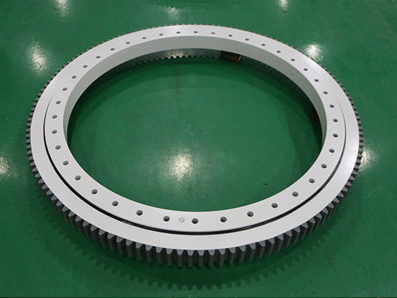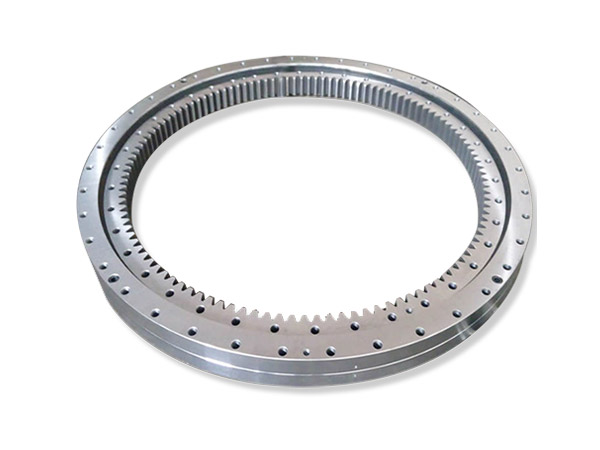What are the sealing methods of the slewing bearing? Sealing function and method
We know that the slewing bearing has a very important role in some production, and in order to ensure these functions, we need to perform a lot of operations on the slewing bearing during the use of the slewing bearing. The sealing of the more common bearings, then why should the slewing bearing be used? to seal? What are the common sealing methods of slewing bearings?
The role of sealed slewing bearing

1. Isolate foreign objects from outside
Protect the bearing to prevent external dust, dirt, metal particles, moisture, acid gas and other debris from invading the inside of the bearing. If the bearing is poorly sealed and external debris invades, the working condition of the bearing will be significantly deteriorated, and the service life of the bearing will be significantly reduced.
2. Prevent grease leakage
If the oil leaks, it will quickly destroy the normal lubrication of the bearing, causing the bearing to burn out due to heat. In addition, the poor sealing device not only causes waste of oil leakage, but also contaminates mechanical equipment and processed products. Therefore, to make the machine work properly, the bearing must have a good sealing device.
The way of sealing the slewing bearing

Generally, the sealing methods of bearings include contact sealing and non-contact sealing, but these two sealing methods are suitable for different situations. Contact sealing is suitable for bearings operating in medium and low-speed working environments, while non-contact sealing Bearings that are suitable for high-speed and high-temperature working environments, as slewing bearings, generally operate at low speeds, but there are also high-temperature operations. The analysis shows that the methods of sealing slewing bearings are as follows:
1. Felt ring seal
A trapezoidal groove is opened on the bearing cover, and the fine felt on the rectangular surface is placed in the trapezoidal groove to contact the shaft, or the gland is pressed axially, so that the felt ring is compressed to generate radial pressure and hug the shaft, thereby achieve the purpose of sealing. The sealing structure is simple and the cost is low, but the sealing effect is poor, it cannot be adjusted, and the wear is serious.
2. The leather bowl is sealed
Place a sealing cup in the bearing cover (the cup is made of rubber and other materials) and press it directly on the shaft. In order to enhance the sealing effect, a ring-shaped coil spring is used to press the inner ring of the leather cup, so that the inner ring of the leather cup and the shaft have a tighter fit, and the sealing effect is better than that of the felt ring. /s of grease lubrication or lubricating oil lubrication.
3. Sealing ring seal
The sealing ring is usually made of leather, plastic or oil-resistant rubber, and can be made into different cross-sectional forms as required. The 0-shaped sealing ring has a circular section and is pressed on the shaft by its own elastic force. It has a simple structure and is easy to assemble and disassemble. Also commonly used are J-shaped and U-shaped profile seals, which all have a lip-shaped structure. The direction of the sealing lip is towards the sealing part, which is similar to the direction of the flange in the cup seal. When the temperature is high and the rotational speed is high, it is recommended that the sealing lip also be installed away from the bearing. The sealing effect of the sealing ring is better than that of the felt ring, and it can be used for the sealing of grease and oil.

4. Skeleton seal
The skeleton seal we often say is the improvement of the leather cup seal. In order to improve the overall strength of the leather cup seal, a metal lining with an L-shaped cross-section and an overall annular shape is installed in the oil-resistant rubber, so that the leather cup seal is not easily deformed and improves the use of This kind of seal is easy to install and has good performance. It is generally suitable for occasions where the peripheral speed of the journal is 7m/s.
5. Sealing ring seal
This is an annular seal with a gap, which is placed in the ring groove of the sleeve, the sleeve rotates with the shaft, and the seal ring is pressed against the static part by the elasticity of the gap after being compressed. On the inner hole wall, it can play a sealing role, and this kind of sealing is more complicated.
6. Labyrinth seal
The basic principle of this kind of seal is to form a section of flow channel with great flow resistance at the seal. Structurally, a small tortuous gap is formed between the stationary part and the rotating part, forming a “labyrinth”. If the “labyrinth” is radial, the axial dimension is compact, but the radial dimension is larger. If the “labyrinth” is axial, the radial dimension is compact, but the bearing cover should be divided, and the axial clearance should be larger, so as not to be stuck due to thermal deformation of the shaft. Labyrinth seals are quite reliable for both lubricating oil and bone grease, and the higher the speed, the better the effect.
The above is the summary of the sealing methods of the slewing bearing, and the whole content of the sealing function and method. We have learned that the slewing bearing has the functions of isolating foreign objects and preventing grease leakage. The common methods are felt ring sealing, leather cup Seal, seal ring seal, skeleton seal, seal ring seal, labyrinth seal, etc., you can choose according to the specific situation of your bearing


